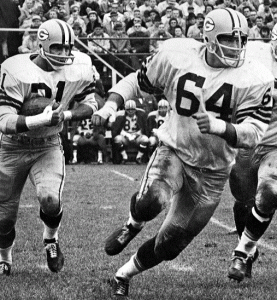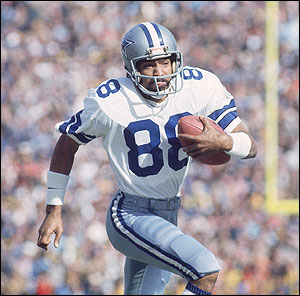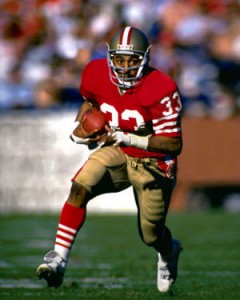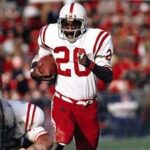10 Players That Deserve Induction Into The Pro Football Hall of Fame
The Pro Football Hall of Fame in Canton, Ohio is where NFL greats take the next step and become immortal legends. Since opening its doors in 1963, 260 former players, coaches and administrators have received football’s greatest honor, but there is a growing list of seemingly deserving players who for one reason or another have been unable to earn a bust in Canton.
Being recognized as a Hall of Famer is certainly an honor that should be reserved for those few players, administrators and coaches that were truly the best of the best. It should be hard and there should be a thin line between being a great player and earning Hall of Fame immortality.
However, after reviewing all members of the Hall of Fame as well as more than 250 former NFL greats who have not yet earned a spot in Canton, it is clear that the Hall of Fame selection committee has been inconsistent in their choices and not done a good job in ensuring that all deserving players are inducted in a timely manner.
The 2010 Hall of Fame class marks the first time since 2001 that the maximum allowed number of inductees, seven, will receive Hall of Fame busts. In back-to-back years of 2004 and 2005 the committee chose only the minimum of four players despite the fact that 12 players who later were chosen for the Hall of Fame were eligible for induction during those years.
In a previous article I outlined my disappointment that the Hall of Fame committee has often made players wait more than 30 years after retirement before being inducted though they didn’t throw a pass, score a touchdown or make a tackle during that time.
While I generally believe that the Hall of Fame committee has done a pretty good job of making selections of players who are deserving of induction, I did also create a list of the 10 players who maybe shouldn’t be in the Hall.
Below is my list of the 10 players who are not in the Hall of Fame who I believe are most deserving of induction. Several have been tantalizingly close to selection, while others have been annually by-passed in favor of players with similar or lesser accomplishments. Hopefully all of them will one day get the thrill of having their bust immortalized in Canton.
I look forward to your comments, discussion, and disagreements.
10. Cris Carter – Philadelphia Eagles/Minnesota Vikings/Miami Dolphins – 1987-2002
Unless something completely unforeseen occurs, it is only a matter of time until Cris Carter will be inducted into the Hall of Fame.
A member of the NFL’s All-Decade team for the 1990s, Carter caught 835 passes in the decade to rank behind only all-time great Jerry Rice.
Originally drafted in the supplemental draft by the Philadelphia Eagles, he spent three seasons in Philadelphia and became known for his ability to get into the end zone.
Of his 89 catches as a member of the Eagles, 19 were for touchdowns, leading Buddy Ryan to quip that “All he does is catch touchdowns.”
Released by Philadelphia because of concerns about substance abuse, he was signed as a free agent by the Minnesota Vikings prior to the 1990 season.
After earning his first Pro Bowl appearance in 1993, Carter led the NFL with 122 catches for 1,256 yards to earn first team All-Pro honors in 1994.
The following season he again caught 122 passes and established career-highs with 1,371 yards and 17 touchdowns.
From 1993 to 2000, Carter averaged 97 catches, 1,182 receptions and 11 touchdowns, while being selected to eight straight Pro Bowls.
He ranks third all-time with 1101 career receptions, fourth with 130 receiving touchdowns and seventh with 13,899 yards receiving.
9. Drew Pearson – Dallas Cowboys – 1973-1983
Perhaps more than any other wide receiver, the explosion of receiving statistics over the last three decades has negatively impacted the Hall of Fame candidacy of Drew Pearson.
Known as “Mr. Clutch” for his uncanny ability to make the big play in game-winning situations, Pearson was a member of the NFL All-Decade team for the 1970s. At the time of his retirement in 1983, Pearson was generally considered a strong candidate for Hall of Fame immortality.
However, that has changed over time as the influx of receivers with huge career statistics has overshadowed the exploits of Pearson and other receivers from his era.
Playing primarily at a time when wide receivers weren’t judged by the number of catches they had, but instead by the productivity associated with those receptions, Pearson ranked in the top 10 in receiving yards five times, including a league leading 870 yards in 1977, and eclipsed the 1,000-yard mark twice in his career.
He was generally considered the best receiver in the NFC for most of his career as he earned first team All-NFC honors four times and was a first team All-NFL selection on three occasions.
But where Pearson truly distinguished himself was in the postseason.
In 22 career playoff games, Pearson caught 67 passes for 1,105 yards and eight touchdowns. His “Hail Mary” reception to defeat Minnesota in the final minute of a 1975 NFC Playoff Game is one of the most famous catches in NFL history.
He also caught a pair of touchdown passes in the final minutes of a come-from-behind playoff win over the Atlanta Falcons in 1980.
At the time of his retirement, Pearson ranked 13th in NFL history in receptions (489) and 19th in receiving yardage (7,822).
It is hard not to compare Pearson to a member of the Hall of Fame who wore the same number as Pearson, number 88, for another prominent NFL squad of the 1970s.
Both Pearson and Lynn Swann were widely recognized for their postseason greatness. However, when it came to regular season success, Pearson far out-shined Swann.
Pearson’s career statistics are far greater than those of Swann (336 receptions, 5,462 yards).
Swann spent his entire career playing alongside fellow Hall of Fame receiver John Stallworth, while Pearson was always the featured receiver for the Cowboys. That might have meant that Pearson received a few more passes thrown his way than Swann, but it also meant that Pearson often faced defenses specifically geared to stop him, something Swann rarely had to face.
Regardless, it is a mystery how Pearson has never been a finalist for the Hall of Fame while Lynn Swann was a finalist for the Hall of Fame 14 times and was inducted in 2001.
8. Ken Anderson – Cincinnati Bengals – 1971-1986
Occasionally overshadowed during his outstanding playing career by other more flamboyant quarterbacks, former Cincinnati Bengals superstar Ken Anderson has also been overlooked in retirement as he has yet to take his rightful place among the all-time greats in the Pro Football Hall of Fame.
One of the most consistent quarterbacks of his generation, Anderson spent much of his career playing in the Bill Walsh system that would eventually evolve into the famous West Coast Offense.
He was a four-time Pro Bowl selection and one-time first team All-NFL selection.
He led the NFL in passer rating four times and ranked in the top 10 on 10 occasions. He also led the NFL in passing yardage twice and completion percentage three times.
His 70.6 completion percentage during the 1982 season still ranks as the highest single season completion percentage in NFL history.
Anderson also had the misfortune of playing in the same division as the Pittsburgh Steelers, which made it tough to earn a playoff bid in an era when only four teams made the playoffs in each conference.
He led the Bengals to seven winning seasons, but they made the playoffs only four times during his 13 seasons as the starting quarterback.
In 1981, Anderson was named the NFL Player of the Year and the Comeback Player of the Year after passing for a career-high 3,754 yards and 29 touchdowns during the 1981 season. The Bengals posted a 12-4 record and earned the first Super Bowl appearance in team history.
Anderson completed 73.5 percent of his passes during Super Bowl XVI for 300 yards and two touchdowns, but the Bengals fell to San Francisco 26-21.
At the time of his retirement, Anderson ranked third in NFL history in completion percentage (59.3%), fifth in passer rating (81.9), seventh in passing yards (32,838), and 12th in touchdown passes (197).
He now stands 37th in completion percentage, 34th in passer rating, 24th in passing yards and 28th in touchdown passes.
7. Roger Craig – San Francisco 49ers/Los Angeles Raiders/Minnesota Vikings – 1983-1993
One inconsistency in the Pro Football Hall of Fame voting is that having been a key member of championship teams seems to be helpful to your chances for induction if you were a member of the Pittsburgh Steelers, Miami Dolphins, Green Bay Packers or Chicago Bears, but not so much for former stars of the San Francisco 49ers, Dallas Cowboys or Oakland Raiders.
That Roger Craig is not in the Hall of Fame and has never even been a finalist makes absolutely no sense. Not only was Craig a key member of three Super Bowl Championship teams, he was a member of the NFL All-Decade team for the 1980s.
A four-time Pro Bowl selection, Craig was one of the greatest combo-backs in NFL history. Initially serving as a fullback, Craig later moved to halfback and proved that he could be a feature runner.
In 1985, he became the first player in NFL history to rush for more than 1,000-yards and catch passes for more than 1,000-yards in the same season. He finished third in the NFL with 1,502 yards rushing in 1988 and was named the AP Offensive Player of the Year.
Craig played in 18 playoff games in his career and had two 100-yard rushing and one 100-yard receiving game during his postseason career.
Craig completed his career with 8,189 rushing yards to rank 34th in NFL history. He also caught 566 passes for 4,911 yards. He ranks 34th in NFL history with 13,100 career yards from scrimmage.
6. Jim Tyrer – Kansas City Chiefs/Washington Redskins – 1961-1974
Because of off-the-field circumstances, it is likely that Jim Tyrer will never be inducted into the Hall of Fame regardless of on-the-field worthiness.
A nine-time Pro Bowl selection and six-time All-Pro, Tyrer was the anchor of the Kansas City Chiefs offensive line for more than a decade. He was a first team choice for the AFL’s All-Time team.
He helped lead the Chiefs to three AFL Championships and victory in Super Bowl IV.
In Super Bowl IV, Tyrer and the rest of the Kansas City offensive line completely dominated the much-heralded defensive front of the Minnesota Vikings.
Unfortunately, all of his success on the field is overshadowed by his tragic death.
After suffering financial misfortunes in his post-football business career, on September 15, 1980, Tyrer murdered his wife and then committed suicide.
He was a finalist for the Hall of Fame the next year, but was not inducted and has not been a finalist since.
Given the current emphasis of Commissioner Roger Goodell on player conduct, it is doubtful that the Hall of Fame, regardless of his prowess as a player, will ever honor Tyrer.
5. Johnny Robinson – Kansas City Chiefs – 1960-1971
Johnny Robinson is one of several members of the all-time AFL team who has somehow been overlooked by Hall of Fame voters.
In the case of Robinson, it is very possible that many Hall of Fame voters just assume that he is already enshrined in the HOF. After all, he was a finalist for the Hall six times between 1980 and 1986.
However, for some reason after receiving such consideration, Robinson was never inducted and has not been a finalist since.
As the leader of the secondary for the great Kansas City Chiefs teams, he helped them win three AFL Championships and twice reach the Super Bowl. He had a key fumble recovery to help seal victory in Super Bowl IV.
Originally an offensive player for the Dallas Texans (later known as the Kansas City Chiefs), he moved to defense in 1962 and established himself as the top safety in the AFL.
He was named to seven Pro Bowls and was a first team All-Pro for six seasons.
He twice had 10 interceptions in a season and led the league in interceptions twice and interception return yards once.
His 57 interceptions still rank as the 10th most all-time.
Hopefully in the 50th anniversary season of the AFL the Hall of Fame voters will re-look at Robinson, Grayson and some of the other stars of the AFL and give them their deserved spots in Canton.
4. Cliff Branch – Oakland Raiders – 1973-1985
Many of the same arguments for why Drew Pearson should be in the Hall of Fame also apply to Cliff Branch.
Branch was one of the elite game-breakers of the 1970s and was a key component of an Oakland/Los Angeles Raiders team that won three Super Bowls during his career.
During his 14-year career, Branch earned Pro Bowl recognition four times and was a first team All-Pro on three occasions.
Complementing the possession receiving of Hall of Famers Fred Bilitnekoff and Dave Casper, Branch was the deep threat that made the Raiders offense dangerous.
His average of 24.2 yards per catch in 1976 ranks as the 21st highest single season average in NFL history and he averaged 17.3 yards per reception for his career.
Branch led the NFL with 1,092 receiving yards and 13 touchdown receptions in 1974 and also caught a league-leading 12 touchdowns in 1976.
In 19 career playoff games, Branch caught 73 passes for 1,289 yards (17.7 ypc) and four touchdowns.
Branch finished his career with 501 receptions for 8,685 yards and 67 touchdowns.
At the time of his retirement, Branch ranked 8th in career receiving yards, 11th in receptions and 15th in touchdown catches. He now ranks 56th all-time in receiving yards, 106th in receptions and 36th in touchdown catches.
3. Chuck Howley – Chicago Bears/Dallas Cowboys – 1958-1973
Occasionally overshadowed on the talented Dallas Cowboy defense by other superstars including Bob Lilly, Jethro Pugh, Mel Renfro and Lee Roy Jordan, Chuck Howley picked the grandest stage for his biggest moments.
In Super Bowl V, he became the first defensive player, and only player ever from a losing team, to earn Super Bowl MVP honors after intercepting two passes and recovering a fumble. He followed that up a year later by recovering a fumble and intercepting another pass the following year in Super Bowl VI.
Playing weakside linebacker, Howley combined with Lee Roy Jordan and Dave Edwards to give Dallas one of the best linebacker corps in the league. Dallas finished in the top seven in the NFL in scoring defense and yards allowed in 10 of Howley’s 11 seasons with the team.
Displaying a nose for the ball, Howley intercepted 25 passes in his career and twice had more than 100 yards in interception returns for a season. He scored a touchdown on a 97-yard fumble return in 1966 and had 18 fumble recoveries during his career.
He was selected to six Pro Bowls and earned first team All-Pro honors on five occasions.
It makes absolutely no sense with some of the players at other positions that have received consideration or been inducted into the Hall of Fame in recent years that Howley and some of the other linebackers on this list have never even been selected as a finalist.
2. Shannon Sharpe – Denver Broncos/Baltimore Ravens – 1990-2003
Once the Hall of Fame voters decide he has waited long enough, Shannon Sharpe is a lock to eventually earn a place in the Pro Football Hall of Fame.
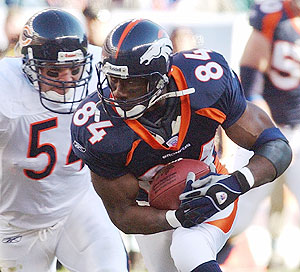
Before being overtaken by Tony Gonzalez, Shannon Sharpe was the most prolific tight end in NFL history.
He was the most prolific tight end of his era and a key member of three Super Bowl Championship squads.
An eight-time Pro Bowl selection and four-time first team All-Pro, Sharpe caught 80 or more passes in a season three times during his career and had 60 or more catches in 10 seasons.
He eclipsed the 1,000-yard receiving mark three times, including a career-high 1,107 yards in 1997.
Sharpe finished his career as the all-time leading receiver among tight ends and still ranks second to Tony Gonzalez.
His career totals of 815 receptions and 10,060 yards rank 18th and 31st, respectively all-time among receivers.
1. Jerry Kramer – Green Bay Packers – 1958-1968
Given the plethora of offensive linemen who have been inducted into the Hall of Fame in recent years (17 since 1996) it makes absolutely no sense that Jerry Kramer has yet to earn a spot in the Hall of Fame.
One of the key members of perhaps the greatest offensive line of all-time, at the time of his retirement few would have believed that 40 years later he would still be waiting to have his name called for the Hall of Fame.
Anyone who followed football in the 1960s knew about the famous Green Bay Packers power sweep. It was the signature play for the great Packer offense that led the NFL in rushing yards three times and finished second three times between 1960 and 1967.
The play relied on the athletic ability of the offensive linemen to pull out from their normal positions and lead block for the running back heading around end. Kramer was ideally suited for the play and often would make crushing blocks to allow Jim Taylor and Paul Hornung, both Hall of Famers, to gain yards and score touchdowns.
He also made perhaps one of the most famous blocks in football history as he paved the way for Bart Starr to score the decisive touchdown in the final seconds of the 1967 NFL Championship game (also known as the “Ice Bowl”).
Kramer was recognized as a first-team All-Pro selection five times during his career and appeared in three Pro Bowls. He was chosen to the NFL All-Decade team for the 1960s.
In 1969, Kramer was one of only a handful of NFL players selected by the Hall of Fame selection committee for the NFL’s 50th Anniversary All-Time team. He is the only member of that team who has not been inducted into the Hall of Fame.
In fact, no player who has not eventually received induction into the HOF has been a finalist for the Hall more times than Kramer. He first was a finalist in 1974 and has been a finalist 10 times with the last time having been in 1997.
So what changed between 1969 and 1974 (and the 35 years since) that have kept Kramer from earning his rightful place in the Hall of Fame?
There are probably two ways to explain why Kramer has been snubbed for so long.
The first has to do with the over-saturation of members of the great Packer teams of the 1960s in the Hall.
Beginning with Jim Taylor in 1976 and ending with Henry Jordan in 1995, 10 members of the 1960s Packers have been selected for the Hall of Fame.
During the time that Kramer was a finalist in seven of eight years (between 1974 and 1981) seven Packers were chosen for the Hall and all but one year included a Packer in the HOF class.
It is possible that Hall of Fame voters decided to slow down a bit on selecting Packers to allow for some balance and then by the time they started choosing Packers again, Kramer had been pushed aside.
After the selections of Willie Davis and Jim Ringo in 1981, no member of the 1960s Packers was chosen again until Paul Hornung in 1986.
The other possible explanation has to do with the perception by some that Kramer’s role on the team has perhaps been exaggerated due to his own self-promotion.
During the Packers’ final Super Bowl season of 1967, Kramer teamed with the late, great Dick Schapp to write the book Instant Replay, which chronicled the final season of the Lombardi Packers.
The book became a best seller and was one of the first books I ever read.
He followed it up nearly 20 years later with the book Distant Replay, which re-connected with members of the great Green Bay teams 20 years after their championships.
The greatness of the Green Bay Packers of the 1960s was in their team chemistry, rather than in the greatness of each individual player.
It is possible that some Hall of Fame voters have perceived the notoriety that Kramer received for his books as excessive self-promotion that over-emphasized his value to the Packers. He also seems to have been anointed as the de-facto spokesman for the Packers of the 1960s as he is always prominently featured in video clips about the team, Coach Lombardi and the era.
Of course in this era when newspaper writers across the country are climbing all over each other to get on television, if Hall of Fame voters are indeed punishing Kramer because they think he craved the limelight, the level of hypocrisy would be beyond description.
My hope is that sometime soon, before it is too late and the now 73-year old Kramer is no longer able to enjoy the moment, Hall of Fame voters overcome whatever reason they have had for overlooking this deserving player and put him in the Hall.
Best of the Rest
While I am only highlighting the top 10 players deserving of Hall of Fame induction, I actually rated the top 25. Below are choices 11 through 25.
Only players who are currently eligible for the Hall of Fame were considered.
11. Chris Hanburger
12. Cortez Kennedy
13. Randy Gradishar
14. John Brodie
15. Robert Brazile
16. Ottis Anderson
17. Steve Atwater
18. L.C. Greenwood
19. Dave Grayson
20. Dermontti Dawson
21. Donnie Shell
22. Richard Dent
23. Ben Coates
24. Ken Stabler
25. Andre Reed
